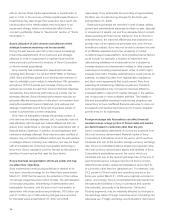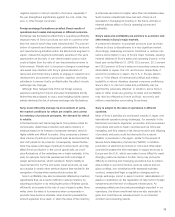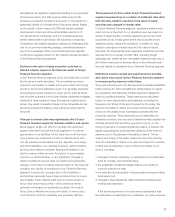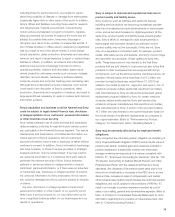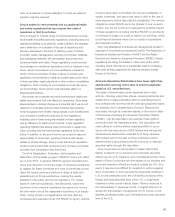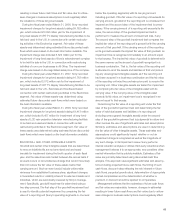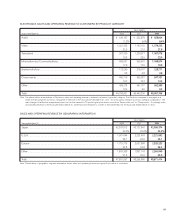Sony 2008 Annual Report Download - page 83
Download and view the complete annual report
Please find page 83 of the 2008 Sony annual report below. You can navigate through the pages in the report by either clicking on the pages listed below, or by using the keyword search tool below to find specific information within the annual report. 81
such as accidents or natural disasters, to which an external
supplier might be exposed.
Sony is subject to environmental and occupational health
and safety regulations that can increase the costs of
operations or limit its activities.
Sony is subject to a broad range of environmental and occupa-
tional health and safety laws and regulations, including laws and
regulations relating to air pollution, water pollution, the manage-
ment, elimination or reduction of the use of hazardous sub-
stances, decreases in the level of standby power of certain
products, waste management, recycling of products, batteries
and packaging materials, site remediation and worker and
consumer health and safety. These regulations could become
more stringent or additional regulations could be adopted in the
future, which could cause us to incur additional compliance
costs or limit our activities. Further, a failure to comply with
applicable environmental or health and safety laws could result
in fines, penalties, legal judgments or other costs or remediation
obligations. Such a finding of noncompliance could also injure
our brand image. Such events could adversely affect our
financial performance.
We monitor and evaluate new environmental and health and
safety requirements that may affect our operations. Sony sees
issues related to climate change as a potential risk if we do not
respond or undertake environmental activities appropriately.
Sony recognizes that climate change issues could possibly lead
to an increase in additional costs due to new regulations
including carbon taxes and governmental policies regarding
energy efficiency for electronics products. A new regulation
regarding logistics has already been introduced in Japan and
other countries may introduce similar regulations in the near
future. In addition, in the event that we are unable to respond
appropriately to consumers’ growing concerns with issues
related to climate change, there is a risk that Sony’s reputation
could be harmed and that consumers may choose to purchase
products from companies other than Sony.
The EU’s Registration, Evaluation, Authorisation and
Restriction of Chemicals program (“REACH”) came into effect
as of June 2007. In general, REACH requires manufacturers,
users and importers of a broad range of chemical substances
to register for these chemicals and uses of chemicals up and
down the supply chain and perform a range of tests and
assessments on those substances, making the results
available to the public and the EU regulators. For certain
types of chemical substances, manufacturers, users and
importers of the chemical substance are required to convey
the information about the designated substance in its supply
chain. Going forward, as registrations and test data are
processed and evaluated under the REACH program, actions
could be taken that could affect the cost and availability of
certain chemicals, and users may have to shift to the use of
more expensive and/or less effective substitutes. The various
obligations under REACH are to be phased in over a period
of time, and we will continue to evaluate the potential impact
of these regulations, including whether REACH could directly
or indirectly increase our costs or restrict our activities, which
could have an adverse impact on our results of operations
and financial condition.
Sony has established an internal risk management system in
response to two directives enacted by the EU: The Restriction of
Hazardous Substances Directive (“RoHS”) and the Waste
Electrical and Electronic Equipment Directive (“WEEE”). Similar
regulations are being formulated in other parts of the world,
including China. We may incur substantial costs in complying
with other similar programs that might be enacted outside
Europe in the future.
American Depositary Shareholders have fewer rights than
shareholders and may not be able to enforce judgments
based on U.S. securities laws.
The rights of shareholders under Japanese law to take
actions, including voting their shares, receiving dividends and
distributions, bringing derivative actions, examining Sony’s
accounting books and records and exercising appraisal rights
are available only to shareholders of record. Because the
depositary, through its custodian agents, is the record holder
of the shares underlying the American Depositary Shares
(“ADSs”), only the depositary can exercise those rights in
connection with the deposited shares. The depositary will
make efforts to vote the shares underlying ADSs in accor-
dance with the instructions of ADS holders and will pay the
dividends and distributions collected from Sony. However,
ADS holders will not be able to bring a derivative action,
examine Sony’s accounting books and records, or exercise
appraisal rights through the depositary.
Sony Corporation is incorporated in Japan with limited
liability. A majority of our directors and corporate executive
officers are non U.S. residents, and a substantial portion of the
assets of Sony Corporation and the assets of our directors and
corporate executive officers are located outside the U.S. As a
result, it may be more difficult for investors to enforce against
Sony Corporation or such persons the judgments obtained in
U.S. courts predicated upon the civil liability provisions of the
federal and state securities laws of the U.S. or judgments
obtained in other courts outside Japan. There is doubt as to
the enforceability in Japanese courts, in original actions or in
actions for enforcement of judgments of U.S. courts, of civil
liabilities predicated solely upon the federal and state securities
laws of the U.S.





